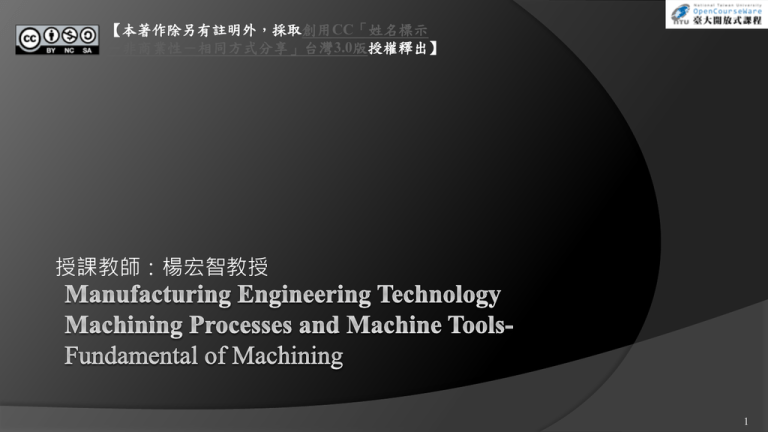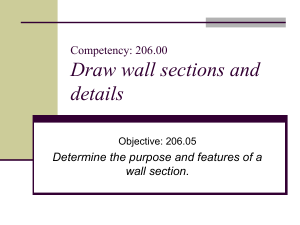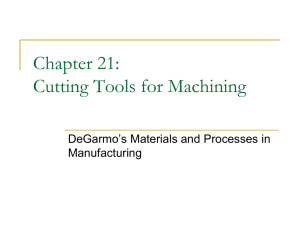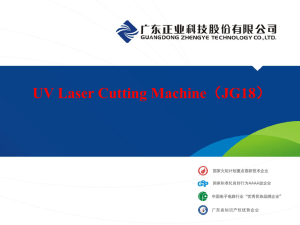Mechanics of Cutting
advertisement

【本著作除另有註明外,採取創用CC「姓名標示 -非商業性-相同方式分享」台灣3.0版授權釋出】 授課教師:楊宏智教授 1 楊宏智(台大機械系教授) 2 Machining Processes and Machine Tools Parts can be manufactured by casting, forming and shaping processes They often require further operations before the product is ready for use Machining Processes and Machine Tools Machining is the removal of material and modification of the surfaces of a workpiece Machining involves secondary and finishing operations Machining Processes and Machine Tools Major types of material removal processes: 1. Cutting 2. Abrasive processes 3. Advanced machining processes Machining operations is a system consisting of the 1. Workpiece 2. Cutting tool 3. Machine tool 4. Production personnel Chapter 21: Fundamental of Machining 6 Chapter Outline 1. 2. 3. 4. 5. 6. 7. Introduction Mechanics of Cutting Cutting Forces and Power Temperatures in Cutting Tool Life: Wear and Failure Surface Finish and Integrity Machinability Introduction Cutting processes remove material from the surface of a workpiece by producing chips Common cutting processes: 1. Turning 2. Cutting off 3. Slab milling 4. End milling Introduction In the turning process, the cutting tool is set at a certain depth of cut (mm) and travels to the left as the workpiece rotates Feed, or feed rate, is the distance the tool travels horizontally per unit revolution of the workpiece (mm/rev) Introduction In idealized model, a cutting tool moves to the left along the workpiece at a constant velocity and a depth of cut Mechanics of Cutting Mechanics of Cutting Major independent variables in the cutting process: 1. Tool material and coatings 2. Tool shape, surface finish, and sharpness 3. Workpiece material and condition 4. Cutting speed, feed, and depth of cut 5. Cutting fluids 6. Characteristics of the machine tool 7. Work holding and fixturing Mechanics of Cutting Dependent variables in cutting are: 1. Type of chip produced 2. Force and energy dissipated during cutting 3. Temperature rise in the workpiece, the tool and the chip 4. Tool wear and failure 5. Surface finish and surface integrity of the work piece Mechanics of Cutting Merchant model is known as orthogonal cutting It is two dimensional and the forces involved are perpendicular to each other Cutting tool has a rake angle of α and a relief or clearance angle Shearing takes place in a shear zone at shear angle Φ Mechanics of Cutting Cutting Ratio The ratio is related to the two angles by As the chip thickness is always greater than the depth of cut, the value of r is always less than unity Reciprocal of r is known as the chip-compression ratio or chip-compression factor A measure of how thick the chip has become Mechanics of Cutting Shear Strain The shear strain that the material undergoes can be expressed as Large shear strains are associated with low shear angles or with low or negative rake angles Based on the assumption that the shear angle adjusts itself to minimize the cutting force, β = friction angle μ = tanβ coefficient of friction Mechanics of Cutting Velocities in the Cutting Zone Since mass continuity is maintained, From Velocity diagram, we can obtained quations from trigonometric relationships, Note also that Mechanics of Cutting: Types of Chips Produced in Metal Cutting Types of metal chips are commonly observed in practice There are 4 main types: a) b) c) d) Continuous Built-up edge Serrated or segmented Discontinuous Mechanics of Cutting: Types of Chips Produced in Metal Cutting Continuous Chips Formed with ductile materials machined at high cutting speeds and/or high rake angles Deformation takes place along a narrow shear zone called the (primary shear zone) Continuous chips may develop a secondary shear zone due to high friction at the tool–chip interface Mechanics of Cutting: Types of Chips Produced in Metal Cutting Built-up Edge (BUE) Chips 1. 2. 3. 4. 5. 6. Consists of layers of material from the workpiece that are deposited on the tool tip As it grows larger, the BUE becomes unstable and eventually breaks apart BUE can be reduced by: Increase the cutting speeds Decrease the depth of cut Increase the rake angle Use a sharp tool Use an effective cutting fluid Use a cutting tool that has lower chemical affinity for the workpiece material Mechanics of Cutting: Types of Chips Produced in Metal Cutting Serrated Chips Also called segmented or nonhomogeneous chips They are semicontinuous chips with large zones of low shear strain and small zones of high shear strain (shear localization) Chips have a sawtooth-like appearance Mechanics of Cutting: Types of Chips Produced in Metal Cutting Discontinuous Chips 1. 2. 3. 4. 5. 6. 7. Consist of segments that attached firmly or loosely to each other Form under the following conditions: Brittle workpiece materials Materials with hard inclusions and impurities Very low or very high cutting speeds Large depths of cut Low rake angles Lack of an effective cutting fluid Low stiffness of the machine tool Mechanics of Cutting: Types of Chips Produced in Metal Cutting Chip Curl Chips will develop a curvature (chip curl) as they leave the workpiece surface Factors affecting the chip curl conditions are: 1. Distribution of stresses in the primary and secondary shear zones. 2. Thermal effects. 3. Work-hardening characteristics of the workpiece material 4. Gometry of the cutting tool 5. Cutting fluids Mechanics of Cutting: Types of Chips Produced in Metal Cutting Chip Breakers A situation that break the chip intermittently with cutting tools have chip-breaker features Mechanics of Cutting: Types of Chips Produced in Metal Cutting Chip Breakers Chips can also be broken by changing the tool geometry to control chip flow Mechanics of Cutting : Oblique Cutting Majority of machining operations involve tool shapes that are three dimensional where the cutting is said to be oblique There is a difference between oblique and orthogonal cutting Mechanics of Cutting : Oblique Cutting Orthogonal cutting the chip slides directly up the face of the tool In oblique cutting, the chip is helical and at an sin i cos i sin sin inclination angle The effective rake angle is 1 e 2 2 n Mechanics of Cutting : Oblique Cutting Shaving and Skiving Thin layers of material is removed from straight or curved surfaces Shaving can improve the surface finish and dimensional accuracy Parts that are long or combination of shapes are shaved by skiving A specially shaped cutting tool is moved tangentially across the length of the workpiece Cutting Forces and Power Knowledge of the cutting forces and power involved: 1. Data on cutting forces 2. Power requirements Cutting force acts in the direction of the cutting speed, and supplies the energy required for cutting Cutting Forces and Power It can also be shown that Resultant force is balanced by an equal and opposite force along the shear plane It is resolved into a shear force and a normal force Thus, The magnitude of coefficient of friction is Cutting Forces and Power Thrust Force The toolholder, work-holding devices, and machine tool must be stiff to support thrust force with minimal deflections The effect of rake angle and friction angle on the direction of thrust force is Magnitude of the cutting force is always positive as the force that supplies the work is required in cutting Cutting Forces and Power Power The power input in cutting is The power dissipated in the shear plane is Denoting the width of cut as w, the specific energy for shearing, is Cutting Forces and Power Power The power dissipated in friction is The specific energy for friction is Total specific energy is Sharpness of the tool tip also influences forces and power Cutting Forces and Power Measuring Cutting Forces and Power Cutting forces can be measured using a force transducer, a dynamometer or a load cell mounted on the cutting-tool holder It is also possible to calculate the cutting force from the power consumption during cutting The specific energy in cutting can be used to calculate cutting forces Cutting Forces and Power EXAMPLE 21.1 Relative Energies in Cutting In an orthogonal cutting operation, to=0.13 mm, V=120 m/min, α=10° and the width of cut 6 mm. It is observed that tc=0.23 mm, Fc=500 N and Ft=200 N. Calculate the percentage of the total energy that goes into overcoming friction at the tool–chip interface. Cutting Forces and Power Solution Relative Energies in Cutting The percentage of the energy can be expressed as where We have Cutting Forces and Power Solution Relative Energies in Cutting Thus, Hence Temperatures in Cutting Temperature rise - its major adverse effects: Lowers the strength, hardness, stiffness and wear resistance of the cutting tool Causes uneven dimensional changes Induce thermal damage and metallurgical changes in the machined surface Expression for mean temperature is Mean temperature in turning on a lathe is given by 1. 2. 3. Temperatures in Cutting Temperature Distribution The sources of heat generation are concentrated in the primary shear zone and at the tool–chip interface There are temperature gradients in the cutting zone Temperatures in Cutting Temperature Distribution The temperature increases with cutting speed Chips can become red hot and create a safety hazard for the operator The chip carries away most of the heat generated Techniques for Measuring Temperature Temperatures and their distribution can be determined from thermocouples Tool Life: Wear and Failure 1. 2. 3. 4. Cutting tools are subjected to: High localized stresses at the tip of the tool High temperatures Sliding of the chip along the rake face Sliding of the tool along the newly cut workpiece surface Wear is a gradual process The rate of tool wear depends on tool and workpiece materials, tool geometry, process parameters, cutting fluids and the characteristics of the machine tool Tool Life: Wear and Failure Tool wear and the changes in tool geometry and they are classified as: a) Flank wear b) Crater wear c) Nose wear d) Notching plastic deformation of the tool tip e) Chipping f) Gross fracture Tool Life: Wear and Failure:Flank Wear Occurs on the relief (flank) face of the tool It is due to (a) rubbing of the tool along the machined surface and (b) high temperatures Taylor tool life equation states that V = cutting speed T = time taken to develop a certain flank wear land n = an exponent that depend on tool and workpiece materials and cutting conditions C = constant To appreciate the importance of the exponent, Tool Life: Wear and Failure:Flank Wear For turning, it can be modified to Since x and y must be determined experimentally for each cutting condition, we have To obtain a constant tool life: The cutting speed must be decreased Depending on the exponents 1. 2. Tool Life: Wear and Failure:Flank Wear Tool-life Curves Tool-life curves are plots of experimental data from performed cutting tests on various materials under different cutting conditions The exponent n can be determined from tool-life curves As temperature increases, flank wear rapidly increases Tool Life: Wear and Failure:Flank Wear EXAMPLE 21.2 Increasing Tool Life by Reducing the Cutting Speed Using the Taylor Equation for tool life and letting n=0.5 and C=120, calculate the percentage increase in tool life when the cutting speed is reduced by 50%. Solution Since n=0.5, we have This indicates that the change in tool life is Tool Life: Wear and Failure:Flank Wear Allowable Wear Land Cutting tools need to be replaced when: 1. Surface finish of the machined workpiece begins to deteriorate 2. Cutting forces increase significantly 3. Temperature rises significantly Tool Life: Wear and Failure:Flank Wear EXAMPLE 21.3 Effect of Cutting Speed on Material Removal When cutting speed is 60 m/min, tool life is 40 min The tool travels a distance of 60 x 40 = 2400 m When cutting speed is increased to 120 m/min, tool life reduced 5 min and travel 600 m It can be seen that by decreasing the cutting speed, more material is removed between tool changes Tool Life: Wear and Failure:Crater Wear Crater wear occurs on the rake face of the tool Tool Life: Wear and Failure:Crater Wear Factors influencing crater wear are 1. The temperature at the tool–chip interface 2. The chemical affinity between the tool and workpiece materials Diffusion rate increases with increasing temperature, crater wear increases as temperature increases Location of the max depth of crater wear, KT, coincides with the location of the max temperature at the tool– chip interface Tool Life: Wear and Failure: Other Types of Wear, Chipping, and Fracture Nose wear is the rounding of a sharp tool due to mechanical and thermal effects It dulls the tool, affects chip formation and causes rubbing of the tool over the workpiece Tools also may undergo plastic deformation because of temperature rises in the cutting zone Tools may undergo chipping, where small fragment from the cutting edge of the tool breaks away Chipping may occur in a region of the tool where a small crack already exists Two main causes of chipping: Mechanical shock & Thermal fatigue Tool Life: Wear and Failure: Tool-condition Monitoring 1. 2. Tool-condition monitoring systems are integrated into computer numerical control and programmable logic controllers Classified into 2 categories: Direct method is observing the condition of a cutting tool involves optical measurements of wear Indirect methods is observing tool conditions involve the correlation of the tool condition with parameters Another similar system consists of transducers, which continually monitor torque and forces during cutting Surface Finish and Integrity Surface finish influences the dimensional accuracy of machined parts, properties and performance in service Surface finish describes the geometric features of a surface while surface integrity pertains to material properties The built-up edge has the greatest influence on surface finish Surface Finish and Integrity A dull tool has a large radius along its edges In a turning operation, the tool leaves a spiral profile (feed marks) on the machined surface as it moves across the workpiece Typical surface roughness is expressed as Surface Finish and Integrity Factors influencing surface integrity are: 1. Temperatures generated 2. Surface residual stresses 3. Plastic deformation and strain hardening of the machined surfaces, tearing and cracking Finish machining is considering the surface finish to be produced Rough machining is to remove a large amount of material at a high rate Machinability 1. 2. 3. 4. Machinability is defined in terms of: Surface finish and surface integrity Tool life Force and power required The level of difficulty in chip control Good machinability indicates good surface finish and surface integrity, a long tool life, and low force and power requirements Machinability ratings (indexes) are available for each type of material and its condition Machinability: Machinability of Ferrous Metals Steels If a carbon steel is too ductile, chip formation can produce built-up edge, leading to poor surface finish If too hard, it can cause abrasive wear of the tool because of the presence of carbides in the steel In leaded steels, a high percentage of lead solidifies at the tips of manganese sulfide inclusions Calcium-deoxidized steels contain oxide flakes of calcium silicates (CaSO) that reduce the strength of the secondary shear zone and decrease tool–chip interface friction and wear Machinability: Machinability of Ferrous Metals Effects of Various Elements in Steels Presence of aluminum and silicon is harmful, as it combine with oxygen to form aluminum oxide and silicates, which are hard and abrasive Thus tool wear increases and machinability reduce Stainless Steels Austenitic (300 series) steels are difficult to machine Ferritic stainless steels (also 300 series) have good machinability Martensitic (400 series) steels are abrasive Machinability: Machinability of Nonferrous Metals Aluminum is very easy to machine Beryllium requires machining in a controlled environment Cobalt-based alloys require sharp, abrasion-resistant tool materials and low feeds and speeds Copper can be difficult to machine because of builtup edge formation Magnesium is very easy to machine, with good surface finish and prolonged tool life Titanium and its alloys have very poor thermal conductivity Tungsten is brittle, strong, and very abrasive Machinability: Machinability of Miscellaneous Materials Machining thermoplastics requires sharp tools with positive rake angles, large relief angles, small depths of cut and feed and high speeds Polymer-matrix composites are difficult to machine Metal-matrix and ceramic-matrix composites can be difficult to machine, depending on the properties of the matrix material and the reinforcing fibers The type of chips and the surfaces produced also vary significantly, depending on the type of wood and its condition Machinability: Thermally Assisted Machining In thermally assisted machining (hot machining), a source of heat is focused onto an area just ahead of the cutting tool Advantages of hot machining are: 1. Reduced cutting forces 2. Increased tool life 3. Higher material-removal rates 4. Reduced tendency for vibration and chatter






